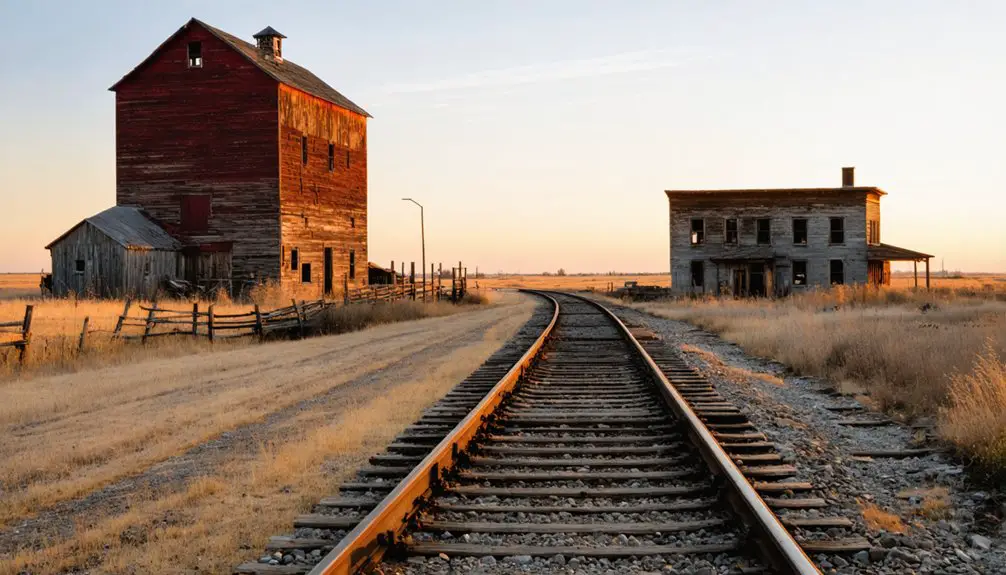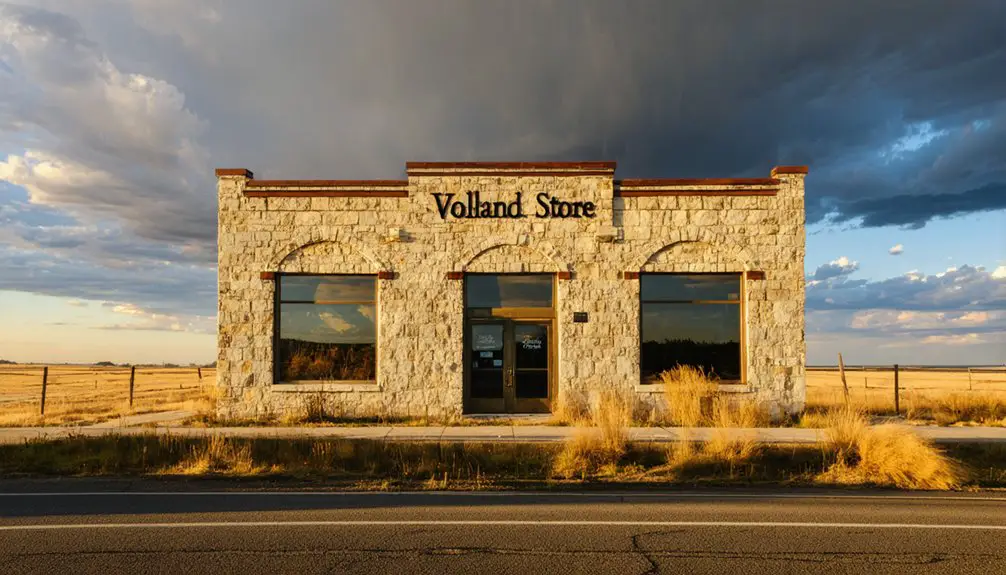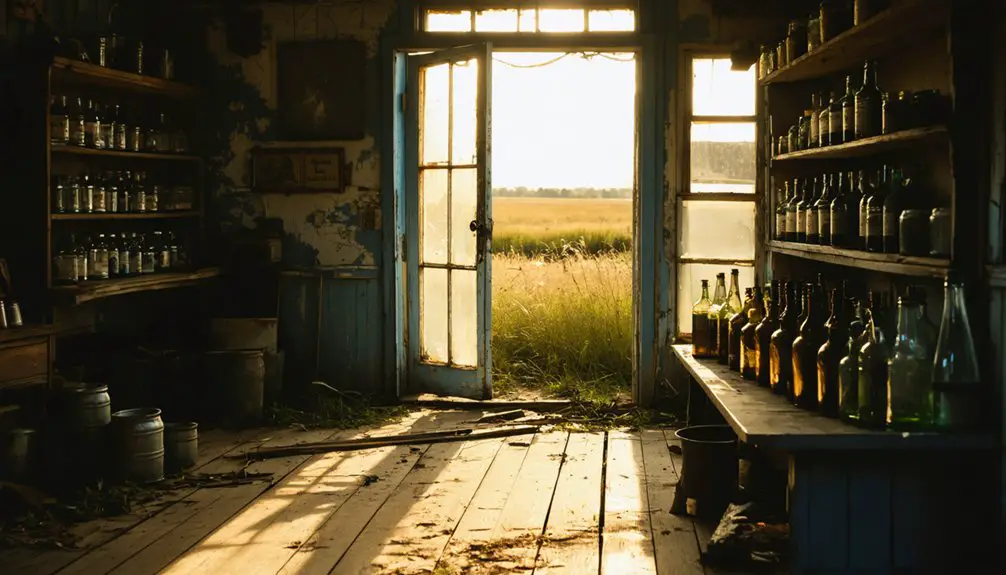You’ll find Volland, Kansas nestled in the Flint Hills, where the Rock Island Railroad once fueled a bustling cattle-shipping hub in the late 1880s. The town’s centerpiece, Kratzer Brothers’ Mercantile Store, served as the heart of the community until the Great Depression sparked its decline. Though now classified as a Class-D ghost town, Volland’s preserved brick store and remaining structures tell a rich story of early Kansas ranching life and railroad commerce that’s waiting to be discovered.
Key Takeaways
- Volland is classified as a Class-D ghost town in Kansas, with only four houses remaining by 1970 after its decline during the Great Depression.
- Originally established in the 1880s by the Rock Island Railroad, Volland served as a crucial cattle shipping hub between Alma and Alta Vista.
- The iconic Kratzer Brothers Mercantile store operated from 1905 to 1971, serving as the town’s social and commercial center before its abandonment.
- Recent preservation efforts have transformed the historic Kratzer store into an art gallery and event space, leading community revival initiatives.
- The town’s population dropped from 400 residents during its railroad peak to near abandonment, though restoration projects are bringing new life.
The Rise of a Railroad Town
As the Rock Island Railroad expanded across Kansas in the late 1880s, they needed a strategic midway point between Alma and Alta Vista where steam locomotives could refuel. They chose a spot along Mill Creek’s banks, establishing a depot, water tower, coal chute, and cattle pens.
Originally named Grafton, local landowners successfully petitioned to rename it Volland in 1890.
The railroad expansion triggered rapid community development, with Washington Township’s population reaching 400 residents.
The Kratzer Brothers Mercantile would later become a centerpiece of the town when it opened its doors in 1913.
You’d have found Volland becoming a crucial commercial hub where trains brought in manufactured goods and transported local agricultural products out.
The town’s position along one of Kansas’ steepest railroad inclines, coupled with the rich Flint Hills prairie grass, made it perfect for the cattle industry and transformed it into a thriving center of commerce.
The store remained a vital community gathering place, serving 350 township residents and staying open late three nights each week.
Otto Kratzer’s Legacy at The Volland Store
Entrepreneur Otto Kratzer made an indelible mark on Volland’s history when he opened Kratzer Bros. Mercantile with his brother Bill in 1905.
The store grew into much more than a retail space after they built their two-story brick building in 1913. You’d find locals gathering there daily, collecting mail, sharing news, and stocking up on supplies. His adventurous spirit led him to travel extensively on his Indian motorcycle. He entertained the community by showing his eight-millimeter films during gatherings.
Otto’s photography captured the soul of this small Kansas town through over 2,500 negatives, documenting everything from cattle drives to everyday moments.
Through his lens, Otto preserved Volland’s heartbeat – each snapshot a window into the authentic rhythms of rural Kansas life.
His adventurous spirit and dedication to the community kept the store thriving as a crucial hub even as economic changes swept through the region.
When Otto died in 1971, the store’s doors closed for good, but his visual legacy lives on, inspiring modern efforts to revive this historic landmark.
From Bustling Hub to Ghost Town
While Otto Kratzer photographed the vibrant life of Volland through his lens, the town’s story took shape around the Rock Island railroad line that birthed it in 1887.
You’d have found a thriving hub powered by railroad expansion, complete with a depot, water tower, and the landmark Kratzer Brothers store that opened in 1904.
But you won’t see that bustle today. The Great Depression triggered a steady community decline, as homesteaders abandoned their farms and businesses shuttered.
Located half a mile south of K-10 on Volland Road, the town is easily accessible to modern-day visitors.
By 1970, even the iconic mercantile store couldn’t survive the exodus. Now, you’ll find just four houses where a main street once hummed with activity.
The red brick store stands partially roofless, a silent sentinel to Volland’s transformation from railroad boomtown to another quiet ghost in the Flint Hills prairie. The town’s remaining two-story brick building, constructed in 1913, serves as a reminder of its more prosperous days.
Architecture That Stands the Test of Time
The Volland Store’s enduring brick construction, built in 1913, stands as a tribute to early 20th-century architectural foresight in rural Kansas.
You’ll notice how the two-story brick design set it apart from typical wooden structures of the era, reflecting both the store’s commercial importance and the practical need for durability against harsh Flint Hills weather.
Even after decades of neglect, the building’s sturdy masonry walls remained intact enough to support its modern restoration as an art gallery and event space, proving the wisdom of those original construction choices. While the building sat abandoned with a missing roof, its strong brick walls remained solid enough for the Reeces to undertake restoration. Today, the building serves as a community center where locals gather to celebrate art and culture.
Historic Brick Construction Details
Built in 1913 during Volland’s railroad-driven prosperity, the town’s two-story brick general store stands as a tribute to early 20th-century construction excellence.
You’ll find its brick durability evident in walls that have weathered over 100 years of Kansas storms while maintaining their structural integrity. The masonry techniques used by builders incorporated locally sourced materials and strong mortar bonds, creating a fortress-like structure that’s outlasted most of its contemporaries.
The building’s practical design features load-bearing brick walls, large windows, and overhanging eaves that protected the masonry. Today, the structure serves as an art gallery following extensive restoration work.
Even after years of abandonment and roof damage, the brick walls remained straight and true, demonstrating why early settlers chose this material for their most important buildings.
Preservation Design Principles
Preserving Volland’s iconic brick general store requires careful adherence to time-tested architectural principles that honor its historical significance.
When you’re working to save this Kansas landmark, you’ll need to focus on preservation techniques that maintain its original form and character-defining features while allowing for necessary modern upgrades. The key is to implement preservation architecture repairs that incorporate original materials whenever possible.
To protect the store’s historical integrity, you must use materials and methods compatible with the original construction. This means matching historic bricks, preserving original workmanship, and ensuring any repairs are reversible.
You’ll want to integrate modern systems like electrical and HVAC carefully, without compromising the building’s authenticity. Regular maintenance will prevent deterioration, while energy efficiency improvements should mirror original appearances.
The Role of Cattle and Commerce

Since its establishment as a railroad town in 1887, Volland emerged as a significant cattle shipping hub between Alma and Alta Vista, where locomotives could replenish coal and water while moving cattle from southern states to the rich grasslands of the Flint Hills.
You’ll find the economic impact of Volland centered around the Rock Island railroad‘s facilities, particularly the cattle pens that enabled a thriving livestock trade. The town’s strategic location made it an essential link in the region’s ranching economy, with the Flint Hills’ nutritious grasses fattening cattle before their final journey to market.
At the heart of this commerce stood the Kratzer brothers’ store, which grew from a modest one-room shop in 1904 to a bustling brick establishment by 1913, serving as both a retail center and community hub.
Life Along Mill Creek
If you’d visited Mill Creek in the 1880s, you’d have seen early settlers building homesteads along its banks while relying on the creek’s steady water supply for their livestock and daily needs.
The arrival of the Chicago, Rock Island & Pacific Railway transformed creek life by establishing Volland as a crucial shipping point, with steep railroad grades requiring careful engineering near the waterway.
Mill Creek’s natural corridor became home to numerous ranching families, like the Claussens, who shaped their daily routines around both the creek’s resources and the railroad’s schedule.
Mill Creek’s Early Settlements
When Jacob and Daniel Blocker ventured west of Washington City in 1858, they became Mill Creek’s first settlers, establishing a foothold in what would become a thriving community.
You’ll find that other pioneers quickly followed, including George G. Pierce, D.E. Ballard, and William Tarbox, all drawn to the area’s rich resources.
These early settlers faced significant challenges, from land survey disputes to finding the right location for their homesteads.
The area’s abundant timber resources proved essential, providing materials for cabins and farms.
While some settlers, like Rufus Darby and M. Woodward, had to relocate due to land title issues, most found permanent homes along the creek’s fertile banks.
The presence of water, timber, and arable land made Mill Creek an attractive destination despite the occasional flooding that threatened their settlements.
Railroad Transforms Creek Life
The arrival of the Rock Island Railroad in 1887 transformed life along Mill Creek, ushering in an era of unprecedented growth and connectivity.
You’d have witnessed the railroad impact firsthand as tracks, depots, and cattle pens sprang up near the newly established town of Volland, originally called Grafton.
The community evolution was dramatic. You’d find the Kratzer brothers’ store serving as the hub of local life, complete with post office and telephone connections to neighboring towns.
The railroad’s presence attracted nearly 400 residents by 1890, enabling farmers and ranchers to ship their goods far beyond the region.
While this new prosperity brought opportunity, it also introduced risks – the flood-prone Mill Creek bottomlands and single-track operations led to several accidents, including a devastating 1907 collision that claimed 32 lives.
Creek-Side Ranching Community
Along Mill Creek’s winding banks, pioneer families like J.R. and Rebecca Fix established thriving ranches that would shape the region’s character for generations.
After the Civil War, they built a grand three-story Italianate home and expansive barn, creating a hub of creek culture that defined local ranch life.
The creek’s waters sustained both livestock and livelihoods, as ranchers capitalized on the rich Flint Hills tallgrass prairie for cattle grazing.
You’ll find this heritage preserved today at the former Fix homestead, now Claussen Ranch and Mill Creek Lodge.
The property maintains its working ranch operations while honoring its past through carefully restored buildings and personalized touches, like guest rooms named after Fix daughters.
Their carved names in the wood floors still whisper stories of early Kansas ranch families.
Modern Preservation Movement
Despite its classification as a Class-D ghost town, Volland has experienced a remarkable preservation renaissance driven by passionate local ranching families and descendants of original homesteaders.
You’ll find their community engagement most visible in the restoration of historic barns, schoolhouses, and the iconic two-story brick store building. The store’s transformation into a cultural hub showcases successful historic preservation while honoring its roots as a social center.
Today, you can explore thoughtfully repurposed structures that serve as venues for art shows and community gatherings. Local historians and artists collaborate to document Volland’s evolution through photography and multimedia storytelling.
While population decline and harsh weather present ongoing challenges, partnerships with regional organizations guarantee these preservation efforts continue to breathe new life into this Flint Hills community.
A New Chapter for Historic Volland

Recent years have ushered in an exciting revival for Volland, as young ranching families and non-resident investors breathe new life into this historic Flint Hills settlement.
You’ll find descendants of original homesteaders actively restoring historic barns and schoolhouses, while community engagement flourishes around the newly renovated Volland Store.
The transformation of Otto Kratzer’s abandoned store into an art gallery represents the heart of this rural revitalization.
What was once a deteriorating brick building with merchandise still on its shelves now serves as a vibrant community hub.
The store’s restoration, along with documented history through Tom Parish’s photography and Greg Hoots’ writings, has sparked renewed interest in Volland’s heritage.
You’re witnessing a ghost town’s rare transformation back into an active rural community.
Frequently Asked Questions
What Natural Disasters or Severe Weather Events Has Volland Survived?
You’ll find Volland’s weathered through typical Kansas severe storms and flood events from Mill Creek, though records don’t show major devastation from tornadoes or Dust Bowl droughts that plagued the region.
Are There Any Documented Paranormal Activities in Volland’s Abandoned Buildings?
You won’t find documented ghost sightings or haunted locations in Volland’s abandoned buildings. Unlike Kansas’s famous paranormal hotspots like McInteer Villa and Sallie House, Volland hasn’t generated any verified supernatural reports.
What Native American Tribes Originally Inhabited the Volland Area?
Picture vast prairies where buffalo once roamed – you’d find the Kanza (Kaw) tribe primarily inhabited this area, with Pawnee, Osage, and Comanche tribes also claiming territories in the surrounding region.
How Did Volland Residents Get Medical Care in the Early Days?
You’d rely on traveling doctors, family caregivers, and home remedies for local health needs. For serious cases, you’d make difficult journeys by horse and wagon to larger towns for early treatments.
Were There Any Notable Crimes or Outlaws Associated With Volland?
You won’t find any notable outlaws or significant criminal incidents in Volland’s history. Historical records show it was a peaceful railroad and farming community focused on commerce and daily life.
References
- https://vollandfoundation.org/brief-history-of-volland/
- https://flinthillsspecial.com/tag/volland/
- https://www.youtube.com/watch?v=PtNS0l-JC_A
- https://wabaunseecomuseum.org/tag/volland/
- https://hcsghosttowns.wordpress.com/2021/08/21/volland-kansas/
- https://www.archdaily.com/776147/volland-general-store-el-dorado-architects
- https://vollandfoundation.org/volland-history-and-nature-trail/
- https://eldo.us/volland-general-store
- https://kansaslivingmagazine.com/articles/2024/05/30/reviving-volland-a-legacy-of-grit-art-and-community
- https://vollandfoundation.org/in-focus-the-photography-and-film-of-otto-kratzer/



